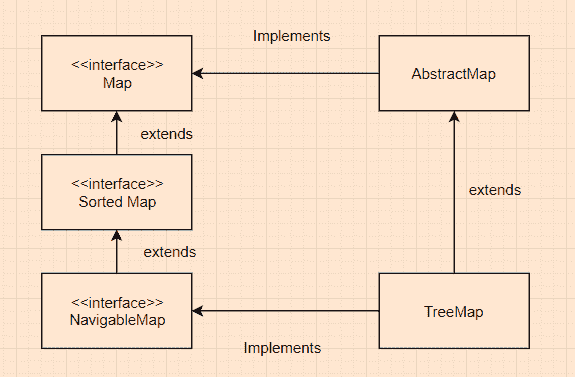# Java `TreeMap`示例
> 原文: [https://javatutorial.net/java-treemap-example](https://javatutorial.net/java-treemap-example)
`TreeMap`实现了`Map`接口,还实现了`NavigableMap`以及`Abstract`类。 映射是根据其键的自然顺序或通过提供初始化时间的[比较器](https://docs.oracle.com/javase/8/docs/api/java/util/Comparator.html)进行排序的。 就时间复杂度而言,此实现为`containsKey`,`get`,`put`和`remove`操作提供了`log(n)`成本。 请务必注意,`TreeMap`不会同步,因为如果地图被多个线程访问,并且如果至少胎面在结构上修改了地图,则必须在外部进行同步。

## 有关`TreeMap`的要点
* `TreeMap`实现`Map`接口。
* `TreeMap`不允许使用空键。 而是,抛出`NullPointerException`。 虽然,多个空值可以与不同的键关联。
* `TreeMap`是 [Java 集合框架](https://docs.oracle.com/javase/8/docs/technotes/guides/collections/index.html)的成员。
## `TreeMap`的继承图

`TreeMap`继承图
## `TreeMap`中的构造方法摘要
1. `TreeMap()`:使用其键的自然顺序构造一个新的空树映射。
2. `TreeMap(Comparator<? super K> comparator)`:构造一个新的空树映射,根据给定的比较器排序。
3. `TreeMap(Map<? extends K, ?extends V> m):`:构造一个新的树映射,该树映射包含与给定图相同的映射,并根据其键的自然顺序进行排序。
4. `TreeMap(SortedMap<K, ? extends V> m)`:构造一个新的树映射,该树映射包含与指定排序图相同的映射并使用相同的排序。
## `TreeMap`类中的方法
1. `void clear()`:删除树形图中的所有元素。
2. `Object clone()`:返回`TreeMap`实例的浅表副本。
3. `Comprator<? super K> comparator`:返回用于对当前映射中的键进行排序的比较器;如果映射使用其键的[自然排序](https://docs.oracle.com/javase/8/docs/api/java/lang/Comparable.html),则返回`null`。
4. `boolean containsKey(Object key)`:如果当前树映射中存在指定的键,则返回`true`。
5. `boolean containsValue(Object value)`:如果当前任意一个地图键都存在指定值,则返回`true`。
6. `V put(K key, V value)`:将指定的值放入指定的键。
7. `V remove(Object key)`:从当前映射中删除指定的键。
8. `V replace(K key, V value)`:仅当当前映射到某个值时,才替换指定键的条目。
9. `int size()`:获取当前树形图具有的元素数。
10. `Collection<V> values()`:返回当前映射中包含的值的[集合](https://docs.oracle.com/javase/8/docs/api/java/util/Collection.html)视图。
有关`EnumSet`主要方法的更多信息,请随时访问原始 [Oracle 文档](https://docs.oracle.com/javase/8/docs/api/java/util/TreeMap.html)。
### 使用`containsKey()`和`containsValue()`检查当前树形图是否包含指定的键或值,并使用`put()`填充`TreeMap`
```java
import java.util.*;
public class TreeMapExample {
public static void main(String[] args)
{
TreeMap<Integer, String> treeMapExample =
new TreeMap<Integer, String>();
// assing values to keys
treeMapExample.put(5, "java");
treeMapExample.put(15, "tutorial");
treeMapExample.put(20, "dot");
treeMapExample.put(25, "net");
System.out.println("Current stage of the treeMap: " + treeMapExample);
// Checking for the key '15'
System.out.println("Is key 15 present in the map: " +
treeMapExample.containsKey(15);
// Checking for the key '5'
System.out.println("Is the key 5 present? " +
treeMapExample.containsKey(5));
// Checking for value "java"
System.out.println("Is the value 'java' present? " +
treeMapExample.containsValue("java"));
// Checking for value "tutorial"
System.out.println("Is the value 'tutorial' present? " +
treeMapExample.containsValue("tutorial"));
}
}
```
**输出**:
```java
Is the key 15 present? true
Is the key 5 present? true
Is the value 'java' present? true
Is the value 'tutorial' present? true
```
### 使用`remove()`从`TreeMap`中删除元素
```java
import java.util.*;
public class treeMapExample {
public static void main(String args[]) {
TreeMap<Integer,String> treeMap=new TreeMap<Integer,String>();
// populating the tree map using put()
map.put(5,"Joe");
map.put(10,"Mike");
map.put(15,"Antony");
System.out.println("Before remove(): ");
// looping through the tree map so we can get each element
for(Map.Entry m:map.entrySet())
{
// print key and value
System.out.println(m.getKey()+" "+m.getValue());
}
map.remove(15);
System.out.println("After remove(): ");
for(Map.Entry m:map.entrySet())
{
// print key and value
System.out.println(m.getKey()+" "+m.getValue());
}
}
}
```
**输出**:
```java
Before remove:
5 Joe
10 Mike
15 Antony
After Remove
5 Joe
10 Mike
```
- JavaTutorialNetwork 中文系列教程
- Java 基础
- Java 概述
- 在 Ubuntu 上安装 Java 8 JDK
- Java Eclipse 教程
- Eclipse 快捷方式
- 简单的 Java 示例
- Java 基本类型
- Java 循环
- Java 数组
- Java 读取文件示例
- Java 对象和类教程
- 什么是面向对象编程(OOP)
- Java 封装示例
- Java 接口示例
- Java 继承示例
- Java 抽象示例
- Java 多态示例
- Java 中的方法重载与方法覆盖
- Java 控制流语句
- Java 核心
- 如何在 Windows,Linux 和 Mac 上安装 Maven
- 如何使用 Maven 配置文件
- 如何将自定义库包含到 Maven 本地存储库中
- 如何使用 JUnit 进行单元测试
- 如何使用 Maven 运行 JUnit 测试
- 如何在 Java 中使用 Maven 创建子模块
- 如何使用 Maven 创建 Java JAR 文件
- 如何使用 Maven 创建 Java WAR 文件
- JVM 解释
- Java 内存模型解释示例
- 捕获 Java 堆转储的前 3 种方法
- Java 垃圾收集
- Java 互斥量示例
- Java 信号量示例
- Java 并行流示例
- Java 线程同步
- Java 线程池示例
- Java ThreadLocal示例
- Java 中的活锁和死锁
- Java Future示例
- Java equals()方法示例
- Java Lambda 表达式教程
- Java Optional示例
- Java 11 HTTP 客户端示例
- Java 类加载器介绍
- Java 枚举示例
- Java hashCode()方法示例
- 如何测试独立的 Java 应用程序
- SWING JFrame基础知识,如何创建JFrame
- Java SWING JFrame布局示例
- 在JFrame上显示文本和图形
- 与JFrame交互 – 按钮,监听器和文本区域
- 如何使用 Maven 创建 Java JAR 文件
- Java Collection新手指南
- 选择合适的 Java 集合
- Java ArrayList示例
- Java LinkedList示例
- Java HashSet示例
- Java TreeSet示例
- Java LinkedHashSet示例
- Java EnumSet示例
- Java ConcurrentHashSet示例
- Java HashMap示例
- Java LinkedHashMap示例
- Java TreeMap示例
- Java EnumMap示例
- Java WeakHashMap示例
- Java IdentityHashMap示例
- Java SortedMap示例
- Java ConcurrentMap示例
- Java Hashtable示例
- Java 中ArrayList和LinkedList之间的区别
- Java HashMap迭代示例
- Java HashMap内联初始化
- Java 中HashMap和TreeMap之间的区别
- Java 图示例
- Java 深度优先搜索示例
- Java 广度优先搜索示例
- 不同的算法时间复杂度
- Java 序列化示例
- Java 反射示例
- Java 中的弱引用
- Java 8 日期时间 API
- Java 基本正则表达式
- 使用 Java 检索可用磁盘空间
- Java 生成 MD5 哈希和
- Java 增加内存
- Java 属性文件示例
- 如何在 Eclipse 上安装 Java 9 Beta
- Java 9 JShell 示例
- Java 9 不可变列表示例
- Java 9 不可变集示例
- Java 9 不可变映射示例
- Java 单例设计模式示例
- Java 代理设计模式示例
- Java 观察者设计模式示例
- Java 工厂设计模式
- Java 构建器设计模式
- Java 比较器示例
- Java 发送电子邮件示例
- Java volatile示例
- Java Docker 和 Docker 容器简介
- 安装和配置 MySQL 数据库和服务器以供 Spring 使用
- 如何在 Java 中使用 MySQL 连接器
- 如何使用 Eclipse 调试 Java
- Java EE
- 如何在 Windows 10 中设置JAVA_HOME
- JavaBeans 及其组件简介
- 如何安装和配置 Tomcat 8
- 如何在 Tomcat 中部署和取消部署应用程序
- 从 Eclipse 运行 Tomcat
- Java Servlet 示例
- Java Servlet POST 示例
- Servlet 请求信息示例
- Servlet 注解示例
- 使用初始化参数配置 Java Web 应用程序
- Java Servlet 文件上传
- Java JSP 示例
- Glassfish 启用安全管理
- 如何使用 MySQL 配置 Glassfish 4
- Java 文件上传 REST 服务
- Glassfish 和 Jetty 的 Java WebSockets 教程
- 基于 Glassfish 表单的身份验证示例
- 如何使用 Java EE 和 Angular 构建单页应用程序
- Spring
- 在 Eclipse 中安装 Spring STS
- 使用 STS 创建简单的 Spring Web App
- Spring Web Framework 简介
- Java Docker 和 Docker 容器简介
- 在 Spring 中实现控制器
- Spring 中的PathVariable注解
- Spring 中的RequestBody注解
- Spring 中的RequestParam注解
- Spring 拦截器
- Spring IOC
- Java Spring IoC 容器示例
- Spring 中的DispatcherServlet
- Spring 示例中的依赖注入
- 实现 Spring MVC 控制器
- Spring ORM 简介
- 什么是 DAO 以及如何使用它
- 如何对 DAO 组件进行单元测试
- 如何对控制器和服务执行单元测试
- 安装和配置 MySQL 数据库和服务器以供 Spring 使用
- 如何在 Spring 中处理登录身份验证
- Spring Security 简介及其设置
- 如何使用 Spring 创建 RESTful Web 服务
- Spring CSRF 保护
- Spring 中基于 OAuth2 的身份验证和授权
- Spring Boot 简介
- Spring MVC 框架介绍
- Spring JDBC 简介
- 如何 docker 化 Spring 应用程序
- Spring 的@Autowired注解
- Spring AOP 中的核心概念和建议类型
- Sping Bean 简介
- 如何在 Java 中使用 MySQL 连接器
- 安卓
- 安装和配置 Android Studio
- 将 Android 设备连接到 Android Studio
- Android 简介,活动,意图,服务,布局
- 创建一个简单的 Android 应用
- 运行和调试 Android 应用程序
- 在虚拟设备上运行 Android 应用程序
- Android 活动示例
- Android 意图示例
- Android 服务示例
- Android 线性布局示例
- Android 相对布局示例
- Android Web 视图示例
- Android 列表视图示例
- Android 网格视图示例
- 带有ListAdapter的 Android ListView示例
- Android SQLite 数据库介绍
- Android SQLite 数据库示例
- Android 动画教程
- Android 中的通知
- Android 中的事件处理
- 如何在 Android 中发送带有附件的电子邮件
- 杂项
- 选择您的 JAVA IDE:Eclipse,NetBeans 和 IntelliJ IDEA
- Java S3 示例
- 如何在 Ubuntu 上为多个站点配置 Apache
- 如何在 Liferay DXP 中替代现成的(OOTB)模块
- 简单的 Git 教程
- 使用 Java 捕获网络数据包
- Selenium Java 教程
- 使用特定工作区运行 Eclipse
- 在 Eclipse 中安装 SVN
- 如何运行 NodeJS 服务器
- SQL 内连接示例
- SQL 左连接示例
- SQL 右连接示例
- SQL 外连接示例
- 树莓派
- Raspberry Pi 3 规格
- 将 Raspbian 安装到 SD 卡
- Raspberry Pi 首次启动
- 远程连接到 Raspberry Pi
- 建立 Raspberry Pi 远程桌面连接
- Raspberry Pi Java 教程
- 使用 PWM 的 Raspberry Pi LED 亮度调节
- Raspberry Pi 控制电机速度
- Raspberry Pi 用 Java 控制直流电机的速度和方向
